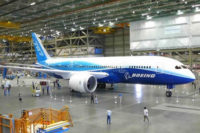Boeing and machinists play a high-stakes game of chicken

On Nov. 13, the International Association of Machinists and Aerospace Workers (IAM) overwhelmingly rejected a contract offer from Boeing that would have kept manufacturing of the company’s new 777X jet in Washington state. The IAM voted down the proposed eight-year contract extension because it would have cut benefits.
Days earlier, the Washington Legislature hastily approved an incentive package—including $8.7 billion in new tax breaks over 16 years—that Boeing had wanted to keep the work in state. Now, that’s in limbo, and some 15 states—including Alabama, Missouri, North Carolina and Texas—are falling over themselves to provide tax breaks, free land and other incentives to the aerospace giant. Even my home state of Illinois claims it’s getting into the act. (Please, stop snickering.)
If the story sounds familiar, it is. In 2009, Boeing threatened to set up a second assembly line for the 787 in South Carolina unless the IAM agreed not to strike for 10 years. (The union had gone on strike for a month in 2005 and again for 57 days in 2008.) The union called Boeing’s bluff—and lost. The company got some $450 million in incentives and built a massive new factory in North Charleston, SC. By last count, the plant expects to add 2,000 jobs by 2020, bringing total employment at the facility to 8,000.
Back then, I defended the move (http://bit.ly/1ebjkUS), and I appreciate Boeing’s position now. It has to think about how to price the 777X today even though the first jets won’t be delivered until 2020. And, after the troubled roll-out of the 787, it’s vital that the new jets be delivered on time.
For their part, IAM members look at Boeing’s big profits and generous executive compensation and wonder why they should have to give back anything. Frankly, they have a point. From 2008 to 2012, Boeing’s gross revenue has increased by 34 percent, while net profit has increased by 46 percent.
During that same period, compensation for Boeing’s CEO, W. James McNerney Jr., and just six other executives increased by a whopping 135 percent, from $32 million to $75.3 million. R&D spending decreased by 12 percent, and from 2008 to 2011, employee salaries and wages increased by only 9 percent. (Curiously, wage data was omitted from Boeing’s 2012 annual report.) Surely, there’s room for a little give and take.
We shall see. On Dec. 10-11, leaders from Boeing and the IAM met to discuss restarting contract talks. Neither session involved formal labor negotiations, and no proposals were exchanged. Even so, it’s a good sign, and we hope the two sides can come to an agreement. If Boeing decides to set up shop elsewhere, it will be a bonanza for one lucky state, and a new aerospace assembly plant anywhere in the United States is certainly a good thing from our perspective. But, where there’s a winner, there’s also a loser, and the consequences for Washington’s economy would be devastating. Let cooler heads prevail.
Looking for a reprint of this article?
From high-res PDFs to custom plaques, order your copy today!






